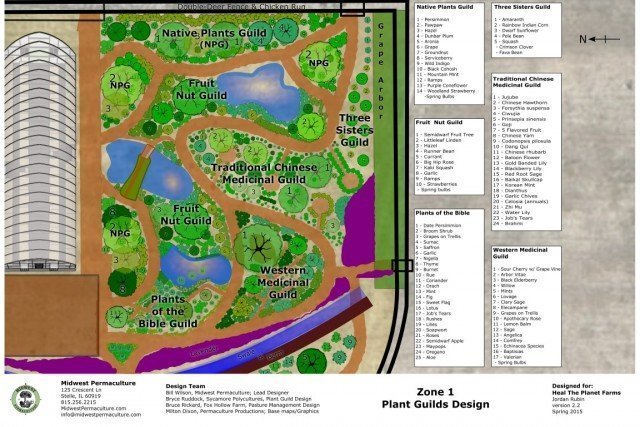Plant Guild Designs for ‘Heal the Planet Farm’, Missouri
- Bill Wilson
Click on Image to View the Full Size (10MB)
Feel free to download, forward, print or share with others. It’s really interesting.
As part of the full design for Jordan Rubin’s Heal the Planet Farm in Koshkonong, MO, we will be creating a demonstration food-forest walk consisting of 6-distinct plant guilds, all designed by Midwest Permaculture’s official plant guy and co-author of Integrated Forest Gardening, Bryce Ruddock. We thought you might like to take a closer look at the final design sketch which was digitally crafted by our fellow teacher/designer, Milton Dixon.
The earthworks and tree planting are scheduled to happen either this fall or in spring of 2016. We’ll keep you posted.
Below is the overview image of where the guild fit into the larger Zone 1 area.
Bill Wilson



5 thoughts on “Plant Guild Designs for ‘Heal the Planet Farm’, Missouri”
Is there housing to purchase around Jordan’s farm?
Not really as we understand it. The farm is fairly remote and there was little public interaction at this location over the several years we were involved. Jordan mostly uses this farm for research and plant/animal stock development.
Brilliant!
So exciting to see permaculture in MO.
Are the plant guilds based on existing systems and meant to be completely self sustaining, or are they groupings intended for research? To design a functioning guild, taking into account the unique relationships between the major plants, interweaving ephemerals, mosses, “weeds,” accommodating (and hopefully enhancing) beneficial mycrorrhizal (sp?) relationships… well, the whole thing is very impressive!
I have created buffer zones around my gardens with MO natives (short leaf pines, redbuds, witch hazel, hazelnuts, etc.) and use dynamic accumulators such as comfrey and yarrow in my mixed annual/perennial fruit and vegetable plantings, but nothing as complex or elegant as what you’ve designed. I look forward to learning more about how it all works long term!
The guilds are based upon the need to establish a demonstration site that showcases possibilities. As such it is both for instructional and research purposes and like all guilds will not be static but change over time as we find which inputs work well and which do not or need tweaking. Plant/soil/wildlife, and yes fungal relationships are all complex interactions that will require constant attention to adapt the individual guilds as well as the overall site to shifting conditions regarding climate averages. Self sustaining? Probably not, but designing a high degree of adaptability into the overall design applications will go a long way to enhance that characteristic. “Weeds” will be evaluated based upon how they are fitting into a niche and what in return they may have to offer to the guild design. Each of the individual guilds will interface with adjacent ones and we will monitor those relationships and where necessary remove plants that seem to not play well with others or are outside of the design imperative for a particular guild, such as native North American plants setting up shop in the Bible Guild. Buffer zones were deliberately not envisioned except for the separation by pathways or water so that research as to the interactions between species can be better observed and learned from.
Thanks for the visuals! I kept trying to picture in my head how to place the plants in reference to each other and with so many options I couldn’t even narrow it down. Your pics helped a great deal. Thank you so much for sharing! Keep up the good work!